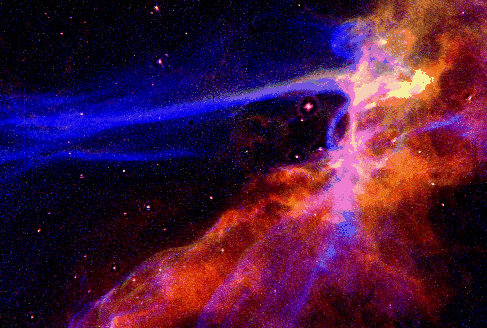Astronomy Picture of the Day
Discover the cosmos!
Each day a different image or photograph of our fascinating universe is
featured, along with a brief explanation written by a professional
astronomer.
March 7, 1996

Rampaging Fronts of the Veil Nebula
Credit: J. J. Hester
(Arizona State University),
WFPC,
HST,
NASA
Explanation:
A supernova explosion of a high-mass star results in fast moving blast
waves. At the front of the waves shown above, ionized gas in the
Veil
Supernova Remnant rushes out from the explosion, sweeps up material, and
breaks up many atoms into constituent ions and electrons.
Observations with
the Hubble Space Telescope
in 1993 indicate that the blue shock wave was
catapult away from the stellar explosion after the red shock wave and has
yet to catch up to it in some regions. The Veil supernova remnant's has a
very large angular size - six times the diameter of the full moon - and
different parts of it are known as the
"Cygnus Loop" and catalogue numbers
NGC 6960, NGC 6979, NGC 6992, and NGC 6995.
Tomorrow's picture: The 76-Metre Lovell Radio Telescope
<
Archive
| Index
| Search
| Calendar
| Glossary
| Education
| About APOD
>
Authors & editors:
Robert Nemiroff
(MTU) &
Jerry
Bonnell (USRA)
NASA Technical Rep.:
Jay Norris.
Specific rights apply.
A service of:
LHEA
at
NASA/
GSFC
&:
Michigan Tech. U.
